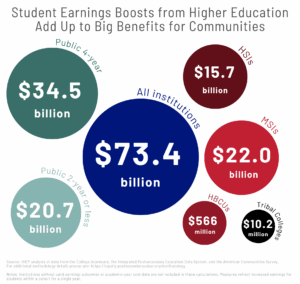Higher Education’s Economic Benefits to Communities
Published Oct 08, 2025
Persistent skepticism about the value of higher education continues to shape public debate. Students, families, policymakers, and taxpayers all want to know whether the resources invested in colleges and universities deliver real returns. Research consistently shows that higher education pays off for most students and employer demand for college-educated workers continues to rise. While individual earnings gains are important, they often overshadow the immense economic benefits higher education brings to communities. By enrolling all types of students and providing access to high-quality credentials and educational experiences, colleges and universities improve students’ lives in economic and noneconomic ways. This, in turn, supports economic development and supports vitality in their communities.
To better quantify these impacts, the IHEP-managed Postsecondary Value Commission developed the Economic Value Contribution (EVC). The EVC measures the combined economic impact of strong student earnings outcomes, multiplied by the total number of students each institution serves. The EVC also quantifies the economic impact of access and enrollment for specific student populations, including among students from families with low incomes, and estimates how much students’ total earnings increase annually after pursuing a college education.

We analyzed EVC figures calculated from the College Scorecard and other public data sources, and unearthed remarkable findings about students’ earnings ten years after initial enrollment:
- Students who attended any college or university generated an estimated total of $73.4 billion in additional annual earnings relative to those of the typical high school graduate, even after accounting for the amount students invested in their education. Students from families with low incomes generated $17.9 billion of this total.
- Students who attended public four-year institutions generated an estimated $34.5 billion in additional annual earnings relative to the typical high school graduate, after accounting for costs to students. This includes $9.2 billion generated by students from families with low incomes.
- Students who attended public two-year or less institutions generated an estimated $20.7 billion in additional annual earnings, relative to the typical high school graduate, even after accounting for student expenses. This includes $5.0 billion generated from students from families with low incomes.
- Students who attended Minority-Serving Institutions generated $22.0 billion in additional estimated annual earnings above the earnings of the typical high school graduate, even after accounting for the amount students invested in their educational costs. This includes $15.7 billion among all students attending Hispanic-Serving Institutions, $466 million among all students attending Historically Black Colleges and Universities, and $10.2 million among all students attending Tribal Colleges and Universities.

These earnings increases apply to a cohort of students in a single year. With each new graduating class, the economic impact grows substantially as a direct result of students’ participation in higher education. For example, one analysis estimated that collectively, former students at all Tribal colleges add $3.8 billion in earnings to the economy each year.
Beyond individual earnings, ample evidence shows that higher education generates far-reaching benefits that ripple across society. When students access high-quality education and complete credentials, they bring increased spending power, skills, and innovation to the communities where they live and work. These gains support local businesses with a more skilled workforce, increased tax revenue that fund public amenities and other government services, and reduced expenditures on criminal justice, public health, and other forms of public assistance. They also strengthen local economies by driving demand for goods and services and attracting further business investment.
These collective impacts matter as much as individual outcomes. Sustained public investments in higher education—including student financial aid and direct support for institutions—are critical to maintaining and expanding economic returns to students and society. And addressing persistent gaps in educational attainment by family income and race and ethnicity would further amplify these public returns. By improving access, affordability, and degree completion for all students, policymakers can ensure that higher education continues to fuel economic opportunity, strengthen communities, and deliver substantial public value for generations to come.
Methodology
We calculate EVC for institutions with median earnings in excess of the minimum economic return (Threshold 0), defined by the Postsecondary Value Commission as the median earnings of the typical high school graduate, plus a measure of the students’ cumulative investment in higher education. All values shown here represent the aggregate amount by which an institution’s median student earnings exceed each institution’s Threshold 0 amount, multiplied by the number of students in the earnings cohort at that institution.
Threshold 0 calculations are based on data on earnings from the American Communities Survey 2023 5-year extract and cost data from IPEDS and the College Scorecard. Data on student earnings are median earnings measured 10 years after students enter an institution, from the College Scorecard collected in calendar years 2020 and 2021 for students who first enrolled between 2009-10 and 2010-11. If an institution’s median earnings are less than T0, or if we do not have valid data for median earnings or cost information at the academic year level, we do not calculate EVC values for that institution. There are 2,347 institutions with valid overall EVC values, including 557 MSIs, but only 46 HBCUs and 6 Tribal Colleges.
For additional details, please see the Equitable Value Explorer’s Methodology page.


